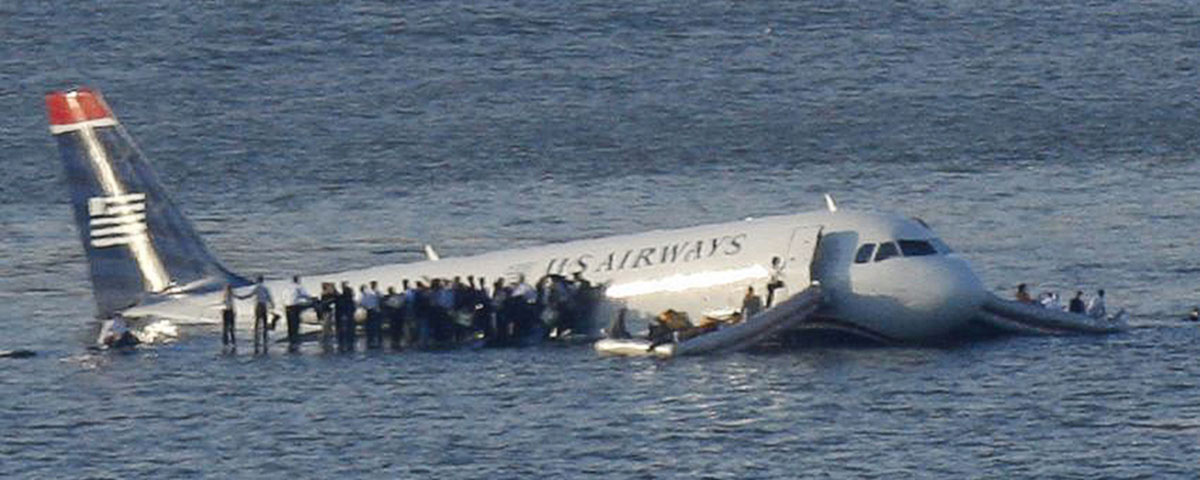‘Ever since the beginning of flight, pilots have been taught to keep in some small corner of their aviator’s toolbox the thought that maybe, just maybe, something will someday require them to land in a way and at a place not of their choosing’
US Airways Captain Chesley Sullenberger’s remarkable ditching of his Airbus A320 in the Hudson River is undoubtedly the most famous forced landing of all time. But ever since the beginning of flight, pilots have been taught to constantly keep in some small compartment of their aviator’s toolbox the thought that maybe, just maybe, something will someday require them to land in a way and at a place not of their choosing. Fixed-wing pilots even practice it, though unless an actual runway is available it’s a kind of emergency interruptus exercise, never carried to its conclusion. (Helicopter pilots practice autorotations to the ground, an adrenaline-pumping maneuver.)
Here are Aviation History’s nominations for the best-ever airplane emergency landings, big and small, heroic and embarrassing, skillful and just plain lucky.
Navajo Save
On a late afternoon in June 1993, air taxi pilot Edward Wyer, a 45-year-old ex-RAF Tornado pilot, took off from Birmingham, England, on a flight to Norwich, about 130 miles due east. Aboard were seven passengers—a load that, in his eight-seat Piper Navajo, made even a low-rent charter airliner seem spacious. The two back-row fares sat with their knees in their faces, and Wyer had a traveler next to him in what normally would have been the copilot’s seat.
Some 40 miles west of Norwich, as Wyer slowly reduced power to begin his descent, there was a huge bang, the airplane shook like a soggy Labrador and both engines went silent.
The right engine, in fact, went away—tore itself from its mounts and fell off. It had shed one of its three prop blades, and the huge rotating imbalance ripped the engine loose. Nor was that the only damage done by the big aluminum blade. Flung with incredible force through the Navajo’s nose, it flew out the other side and into the left engine’s prop, killing that engine.
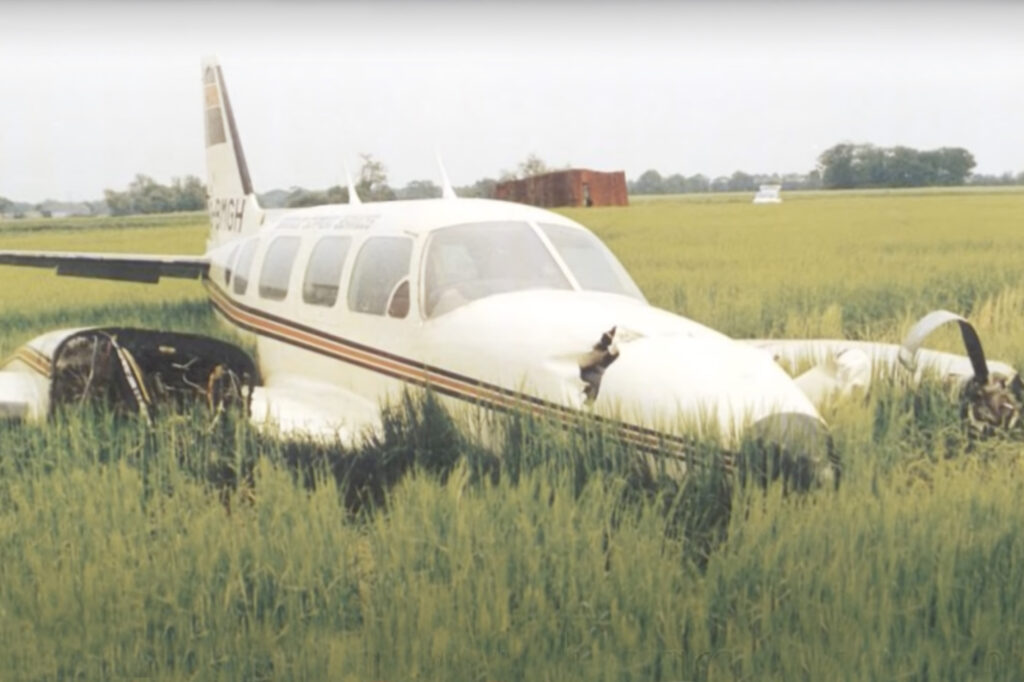
Meanwhile, the sudden asymmetry had snapped the Piper into a tight spin to the right, which Wyer managed to correct after only two turns—nice work even if you’re fully prepared for a practice spin in an intact airplane. Wyer tried his best to reach a satisfactory glide angle, but at anything less than a steep descent at 130 knots, the airplane began to roll uncontrollably.
Coming down fast, Wyer spotted an open field to his left and without hesitation turned toward it, even though the approach path was complicated by powerlines. It took two hands on the yoke and all his strength to manage the airplane, so there was no way Wyer could hand-pump the flaps and landing gear down with the emergency handle, but he managed to get over the wires and put the Navajo down on its belly so gently that the sole injury was to a passenger who later claimed whiplash.
Accident investigators were able to verify the exact place where the Navajo’s tail had first brushed a tall stand of crops, and the neatly cut swath showed that the airplane had sunk inch by inch over a 2,300-foot flare and slid a smooth 460 feet after ground contact.
Snapped Wing Spar
While practicing for the 1970 world aerobatic flyoff, British champion Neil Williams felt the wing spar of his Zlin 526 suddenly fail during a pullout from a vertical dive. As he instinctively closed the throttle and tried to level off, Williams realized that the left wing was folded at nearly a 45-degree angle to the fuselage, severed at the root but still somehow held in place.
Sure that he was about to die, Williams flashed back to a Bulgarian Zlin pilot who’d snapped an upper wing bolt while flying inverted. When that airplane flick-rolled upright in reaction to the suddenly askew spar, the wing flopped back into position under positive Gs and held until the stunned pilot landed. Williams figured that if he’d had the opposite failure upright, maybe he could invert the Zlin and hold the wing in place with negative Gs long enough to at worst crash-land inverted, perhaps into trees to cushion the impact.
With the airplane on its back and the broken wing indeed maintaining a tenuous connection, Williams now had another problem: The Zlin’s engine died. He’d inadvertently jostled the fuel cock closed during the confusion, but he got the engine restarted, remembering to select the correct tank for inverted flight.
The airfield from which he’d departed, RAF Hullavington, was now nearby, and his ground crew had already summoned crash trucks, so Williams decided to land there. He flew the pattern and final approach inverted and at the last possible moment rolled the Zlin upright and flopped onto the ground just as the left wing totally failed.
At the last possible moment? Consider this: The Zlin’s left wingtip briefly furrowed the airstrip grass for six yards while the airplane rolled from inverted to level, yet never broke the plastic cover of the wingtip nav light.
The Gimli Glider
When the pilots of Air Canada Flight 143 heard a deep “BONG” in the cockpit on July 23, 1983, it was a warning bell they’d never heard before, even during simulated training emergencies. No wonder: The sound signified that both engines were out of fuel, an inconceivable situation for a state-of-the-art Boeing 767-200 placidly en route from Montreal to Edmonton, Canada.
The chain of events that led to this stunning situation included an inoperative fuel-quantity indicating system and a top-off in Montreal done in metric units of jet fuel that the crew assumed were gallons. That was the bad news. The good news was that Captain Robert Pearson was a sailplane pilot, and he quickly came up with what he figured was the 767’s best glide speed for maximum distance and turned toward Winnipeg, which seemed within range. Even more fortuitous was that 1st Officer Maurice Quintal had been stationed at a base called Gimli when he was in the Royal Canadian Air Force, and Gimli was even closer than Winnipeg. Quintal proposed Gimli as an option. He wasn’t aware, however, that Gimli RCAFB had become Gimli Industrial Park Airport, a casual general aviation field that had converted one of its two runways into a dragstrip.
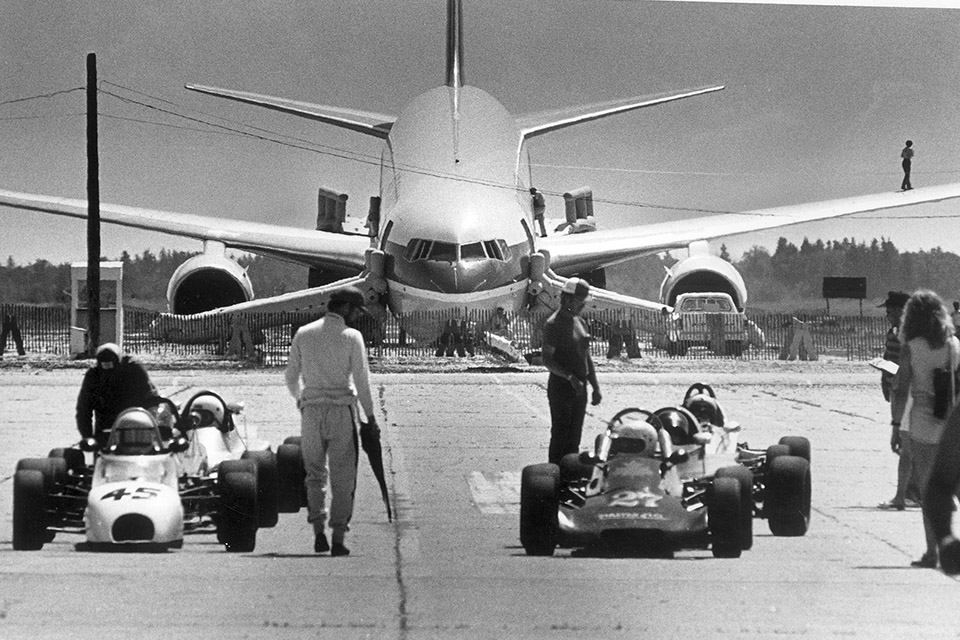
Without power except from a ram-air turbine (RAT) emergency hydraulic unit, the 767’s glass-cockpit instrument panel was totally dark, with only a few small backup gauges to provide basic speed, altitude and heading information. And as the airplane slowed to approach speed, the RAT put out less power and the hydraulically operated controls became harder to move.
With Pearson flying, Quintal put the landing-gear handle down on approach to Gimli’s east/west runway. It turned out to be the deactivated one, that day hosting an autocross and covered with sports cars, RVs, campers, drivers and spectators. With no power, the main wheels free-fell into place, but the nose-gear strut never locked down.
Pearson realized that he was too high and kicked the big Boeing into a substantial, cross-controlled sideslip to lose altitude. It was a technique to which he was accustomed in gliders but a sporty maneuver in a 95-ton sweptwing jet. The 767 touched down hard and then experienced the final fortunate circumstance of the day: While racers scattered in every direction and Pearson braked like a Corvette driver staring at a hairpin turn, the nose-gear strut collapsed, and the 767’s nose ground the airplane to a halt just short of the carnage it might have created while rolling.
The only injuries among the 61 passengers were a few minor ones suffered during the inflatable slide evacuation.
Piggyback Ansons
The Avro Anson, roughly the size of a Twin Beech, was a ubiquitous British Commonwealth twin-engine trainer during World War II, but it was hardly so common that two identical Ansons might collide in the vast, cloudless sky over New South Wales, Australia, on September 29, 1940. Yet not only did they collide, they did so gently enough, while flying in exactly the same direction at the same altitude, that they created a large, four-engine biplane—forever to be known in Oz as the “Piggyback Ansons.”
Royal Australian Air Force Leading Aircraftman Leonard Fuller was slowly descending to cruise at a lower altitude in his Anson Mk. I when he pancaked onto the Mk. I of LAC Jack Hewson, who had been flying level, unseen directly below him. The mating was facilitated by the fact that Ansons had clumsy, hand-cranked retractable landing gear that took a numbing 140 turns to raise and another 140 to extend for landing. So if they weren’t in a hurry, Anson pilots like Fuller often simply left the gear down and accepted the 30-mph speed penalty. This meant that Fuller’s airplane essentially straddled Hewson’s, its wheels sitting atop Hewson’s wings.
Hewson, stunned but survival-minded, firewalled his two throttles, locked the yoke for level flight with his seatbelt, crawled out of the shattered cockpit side window and parachuted free. Fuller, meanwhile, found that he could actually fly the tandem, since all his flight controls were untouched and operable, and the two roaring, overboosted engines Hewson had left behind—plus Fuller’s still-running right engine—were adequate to keep the pair in the air.
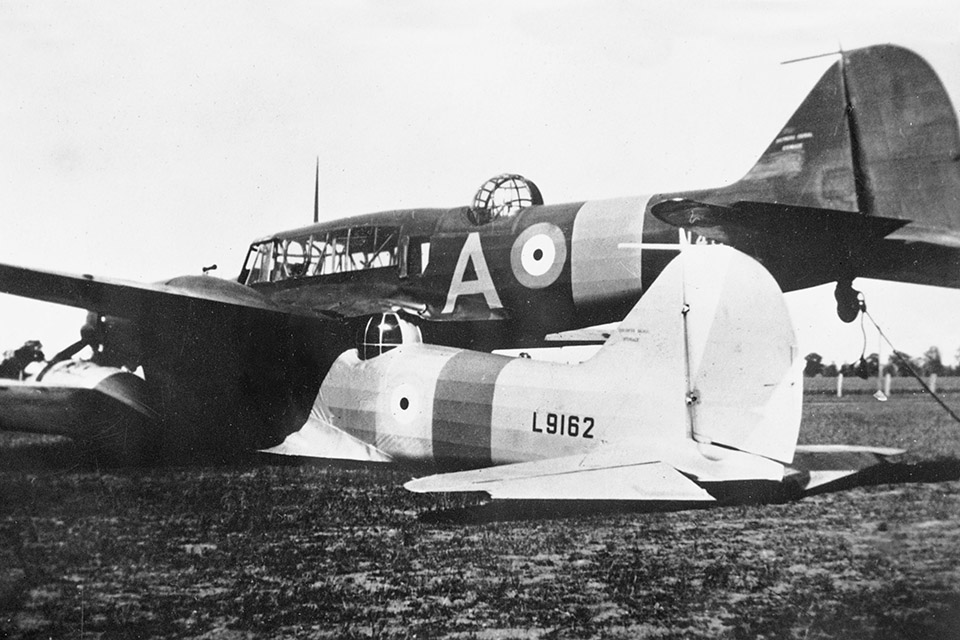
While the Ansons descended through 500 feet to what Fuller hoped would be a controlled crash, the bottom airplane’s engines seized, one after the other, from the stress of a power setting meant to be maintained for only a few minutes during takeoff. The Anson duo sank rapidly, but as he approached a farm field, Fuller two-blocked his own right throttle and flared in ground effect, touching down so lightly—yes, Hewson had also left his landing gear down for the flight—that the only damage to the airplanes was from the midair. Hewson’s airplane was a write-off, but Fuller’s was easily repaired and flew on with the RAAF for another seven years.
The Show Must Go On
RAF Flight Lt. William Reid was the lone pilot of an Avro Lancaster on the way to Dusseldorf with a load of bombs on the night of November 3, 1943. Barely halfway to the target and just past the Dutch coast, Reid took a burst through his windscreen from a Messerschmitt Me-110G night fighter and was hit in the shoulders and hands, his head raked by splinters of sharp Perspex. The attack had also damaged the elevator trim and left the Lanc without compasses. A lesser man would have done a 180 and headed home, but Reid soldiered on. (Unlike U.S. heavy bombers, Lancasters were single-pilot airplanes without dual controls. The flight engineer sat where a copilot normally would, on a seat that folded to provide access to the bombardier’s compartment.)
A Focke Wulf Fw-190 “Wilde Sau” night fighter found them soon thereafter and did worse damage, killing the navigator, mortally wounding the radio operator and disabling the airplane’s oxygen system. Reid was hit again, but the flight engineer, despite a bullet through one arm, was able to bring him a portable O2 bottle. They were still nearly an hour from the target, but Reid managed to dead-reckon to Dusseldorf so precisely that the automatic strike camera later showed their bombs dead on target. Only the engineer was aware of how grievously wounded the pilot was; Reid had said nothing on the intercom.
Weak from spilled blood, Reid set a course for home by the North Star and the moon. The oxygen bottle was empty, and the shattered windscreen bathed him in a 215-mph blast of bitter November air. Somehow the flight engineer helped to keep the semi-controllable Lanc on course, through the inevitable flak barrages along the Dutch coast and across the North Sea to the flatlands of Norfolk. With the USAAF base at Shipdham in sight, a tenacious Reid, blood from his freshly opened head wounds obscuring his vision, was roused to make the night landing between two rows of runway lights barely glimmering through ground fog. The Avro settled to earth heavily but safely even though the damaged legs of the one main gear gave way.
For his airmanship, courage and devotion to duty, Bill Reid was awarded the Victoria Cross.
Into the Rain Forest
There are times when pilots will become heroes, if only briefly, for safely extracting themselves and their passengers from bad situations of their own making, and so it was for the crew of Brazilian airline Varig’s Flight 254 on September 3, 1989.
It had been a long day for the crew of the Boeing 737. The airplane had taken off from São Paulo in the morning and flown north most of the length of Brazil, with half a dozen stops en route, when they reached Maraba, about 200 miles south of their final destination, Belém. At 5:30 p.m., they prepared to again take off. Captain César Garcez glanced at the printed flight plan and saw that the course to Belém was “0270.” That meant a heading of 027.0 degrees—north-northeast. Yet Garcez incomprehensibly read it as 270 degrees—due west, straight into one of the least-inhabited parts of Brazil, the
jungles of the northern Mato Grosso. It was an act akin to a pilot bound from San Francisco to Seattle instead pointing his airplane at Hawaii.
By the time the two crewmen realized their error—Garcez’s copilot, Nilson de Souza Zille, unquestioningly accepted the captain’s course—they were too low on fuel to save themselves. At 8:40, more than two hours after they were due in Belém, Garcez radioed air traffic control that he would be landing in the rain forest, though he still had no idea where. Garcez flew on until he’d emptied the Boeing’s fuel tanks, since there was no way to dump fuel and he wanted to land with the least possible risk of fire. When the engines finally sighed to a stop, Garcez was unable to extend more than a minimal amount of flaps, with hydraulic power fast fading, and could barely make out the horizon from the light of faraway fires. He had no cockpit lights and few working instruments, yet he managed to flare the 737 into the tops of rain forest trees as high as an 18-story building. As the Boeing found the ground, its wings tore off and it quickly slid to a stop. Thirteen people died, but 41 survived. The crewmen were briefly lauded for their skill…until it became obvious why they’d needed it.
When Throttles Are Your Only Flight Control
It’s widely agreed among air transport pilots that the safe touchdown of a near-uncontrollable Airbus A300 at Baghdad International Airport on November 22, 2003—after it was hit by a shoulder-fired missile—qualifies as one of the most remarkable emergency landings of all time. The A300, a DHL cargo flight, had totally lost all three of its hydraulic systems within a minute of the missile strike at 8,000 feet on climb out, which meant that its ailerons, spoilers, elevators, rudder and flaps were immovable. It was also rapidly leaking fuel and on fire, a blaze that, it has been estimated, would have burned through the left wing’s main spar had the flight lasted just eight minutes longer.
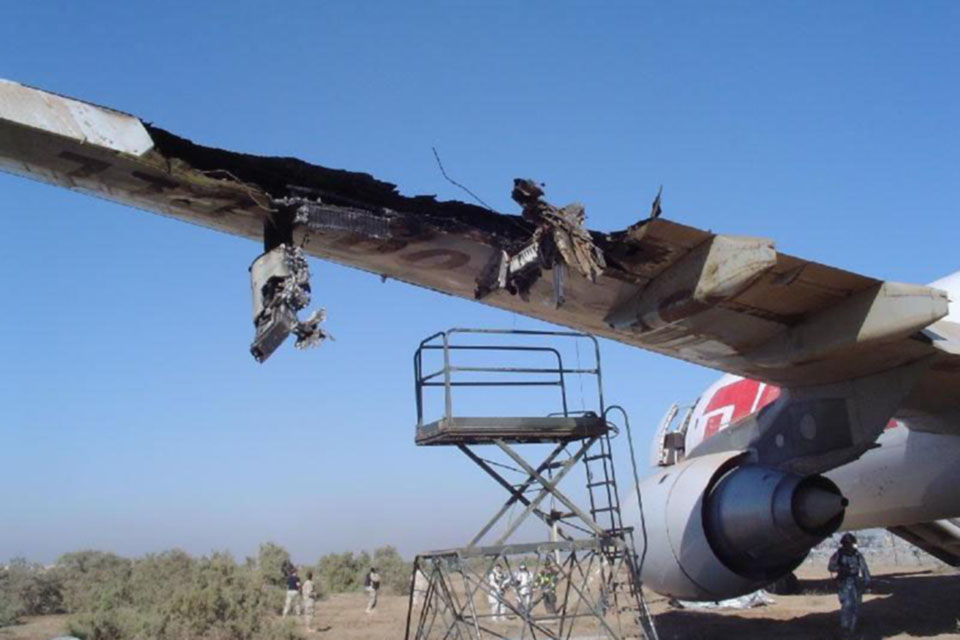
Not long before the incident, Captain Eric Gennotte had attended a flight safety seminar where he heard a presentation by retired United pilot Al Haynes, who had suffered a similar total hydraulic failure in a DC-10 near Sioux City, Iowa. Haynes and his crew had figured out how to “thrust vector” to steer the airplane—power increased on one wing engine or the other for yaw control, power forward or back evenly on both to climb or descend—and it was a lesson that Gennotte filed away for future reference.
Flight Engineer Mario Rofail played a huge part in the save as well, as did 1st Officer Steeve Michielsen. Fuel had flooded out of the big left outboard wing tank, and the left inboard tank was leaking rapidly. Rofail had to quickly and correctly crossfeed fuel from the right wing in a manner that wouldn’t add to the leakage but would feed the left engine; had that engine stopped even briefly, the sudden asymmetric thrust would have doomed the airplane.
As soon as the flight controls failed, the ’Bus began porpoising and rolling as much as 30 degrees left and right. Rofail immediately dropped the landing gear, which helped slow and stabilize the airplane. It took only 10 minutes or so for the pilots to work out their thrust-vectoring skills, and they initiated an approach back to Baghdad. In fact they had become good enough at controlling the airplane that when the approach went bad, they were able to climb away and line up with a different runway. This time they touched down successfully, though the airplane rolled off the runway into the dirt bordering it.
When the A300 had stopped and the crew evacuated the cockpit, they began to run from the scene, but crash crews stopped them. They were in the middle of an uncleared minefield.
On One Wing and a Prayer
On May 1, 1983, over the Negev Desert, Israeli Air Force pilot Zivi Nedivi was practicing air combat maneuvering with his big twin-engine F-15D Eagle, dogfighting a tricky A-4 Skyhawk that was playing the aggressor role. Unfortunately, the Skyhawk went inverted as Nedivi was descending through its altitude, and neither pilot could see the other. The ensuing collision tore off the F-15’s entire right wing—not just a piece of it but the complete wing from the root outward. (The A-4 was a fireball, but its pilot ejected successfully.) The F-15 immediately went nose-down and spun, and Nedivi told his back-seat instructor to prepare to eject.
Fortunately, Nedivi instinctively did the one thing that might save the airplane: He pushed the power levers through the afterburner gate, and the speed stabilized the half-an-airplane enough that he could actually control it.
The instructor urged ejection anyway, but Nedivi, who outranked him, refused; he thought he could land the airplane. “I probably would have ejected if I knew what actually had happened,” he later admitted, but a huge spray of fuel pouring out of the right wing root totally obscured where the wing would have been, and neither Nedivi nor his wingman could see that it was no longer there.
Nedivi flew the F-15 for some 10 minutes, back to the nearest IAF desert base, and there found that he needed to keep the approach speed at nearly 260 knots—fully twice the airplane’s normal landing speed—to forestall an uncontrollable roll. The F-15 touched down wings-level—make that wing-level—but was traveling so fast that when its emergency tailhook snagged a snubbing cable a third of a way down the runway, the hook simply tore off the fighter. Nedivi braked to a stop about 20 feet from the end of the 11,000-foot runway and turned in his seat to shake the instructor’s hand. It was the first time he could see that the right wing was gone. (Click here to see a video about the landing on YouTube.)
Nedivi reportedly was demoted for disobeying his instructor’s order to eject and immediately thereafter promoted for saving his airplane—which two months later was repaired and flying again.
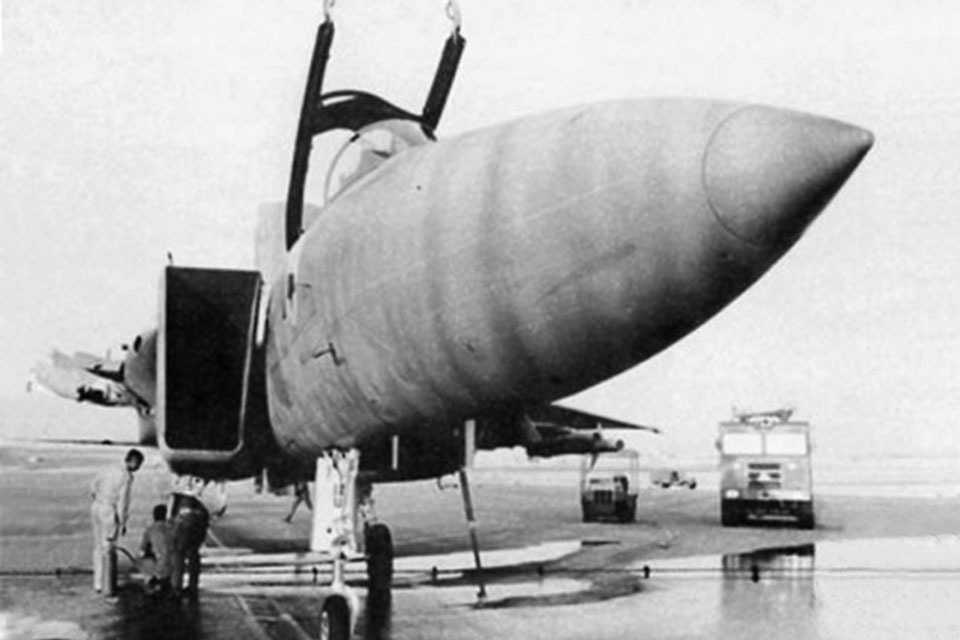
“Fill Her Up”
On an early spring Saturday in 1975, professional aerobatic and movie pilot J.W. “Corkey” Fornof was flying a Bede BD-5J, a tiny, single-seat microjet, to a NASA gathering of space shuttle subcontractors in Washington, D.C., where the airplane was to be displayed. Level at 11,500 feet over North Carolina, Fornof suddenly lost all oil pressure on the watermelon-size French TRS-18 turbojet that powered the airplane. He shut down the engine and glided toward the solid cloud layer below him—a spunky move, since he couldn’t be sure what was below it.
Fortunately, Fornof broke out of the undercast about 800 feet above a thick pine forest, saw Interstate 95 several miles to the west and was able to line up with the highway for a landing. He skimmed over a Mayflower moving van and briefly considered landing atop it, since traffic was heavy, “but I had a Road Runner cartoon vision of coming to an overpass and figured that wasn’t a good idea,” he recalled. Fornof still had plenty of speed, and he remembers gliding past a Cadillac—“they waved at me”—and coming up behind a pickup towing a boat. “I came up abeam the driver and motioned that I wanted to slide in ahead of them, and the guy simply slowed down and motioned me past. I don’t know what he was smokin’, but he was cool as could be.”
Fornof touched down gently, crested a hill and rolled down the other side to an off-ramp. At the bottom of the exit was a mini-mall and a Sunoco gas station, so Fornof used the last of the Bede’s momentum to roll up to the pump island, activating the little rubber ding-ding hose in the process. The station attendant was leaning against the doorway, and, said Fornof, “We stared at each other a good 15 seconds, and he spit out his chaw and said, ‘Is this Candid Camera?’”
Corkey flew a BD-5J in the James Bond film Octopussy, in which his most spectacular stunt was flying the microjet through a hangar—in one door and out the other end—but the highway landing experience was also worked into the plot: Bond (Roger Moore) runs out of fuel in the Bede, lands on a rural two-lane and rolls into a gas station, where he tells the slack-jawed attendant to “Fill her up, please.”
Wing-Walkers
Canadian 2nd Lt. Alan McLeod was just 18 years old when he was awarded the Victoria Cross during World War I for a heroic crash-landing that he performed while standing on the wing of his Armstrong Whitworth F.K.8 single-engine bomber. Licked by flames from its burning gas tank, wounded five times by attacking Fokker Dr.I triplanes, he maneuvered the F.K.8 so the fire streamed clear of his also-wounded rear gunner. He managed to crash-land the airplane near enough to British lines that he was able to crawl to safety, dragging his gunner along with him.
McLeod had tried to join the military when he was 14 and was finally accepted at 17. He soloed in five days and earned his wings in less than two months. During his brief time in combat, he shot down one German observation balloon and had several dogfights with German fighters—quite an accomplishment in a bomber/reconnaissance plane.
On March 27, 1918, McLeod and his observer, Lieutenant A.W. Hammond, were about to bomb a German artillery battery when they were attacked by a Fokker Dr.I that Hammond, with the help of McLeod’s maneuvering, subsequently shot down, only to be attacked by seven more triplanes. Hammond downed two more before a bullet pierced his fuel tank, setting the big plane ablaze.
McLeod’s VC citation claims that he “climbed out onto the left bottom [wing], and by sideslipping steeply kept the flames to one side, thus enabling the observer to continue firing until the ground was reached.” And so the legend has come down to us, though pilots who hear it realize that a sideslip is impossible without the use of the rudder controls, which McLeod couldn’t have reached from his position on the wing.
Perhaps McLeod cross-controlled the bomber into a slip while he was still in the cockpit. Then, when he climbed onto the wing, the stiff, primitive controls might have held the right-rudder deflection. Whatever the case, the young Canadian flew the airplane from outside the cockpit so competently that both he and Hammond survived the controlled crash.
Nor is this the only case of a perambulating World War I pilot. During a wild dogfight on September 5, 1918, New Zealander Keith Caldwell found himself with a barely controllable S.E.5a after a midair collision with one of his RAF squadron mates. As he neared the ground, Caldwell climbed out of the cockpit onto the left wing, held a cabane strut with his left hand and worked the control column with his right, hoping to jump off just before the airplane crashed. Skimming over the British trenches, he leapt clear, made a few somersaults on the ground and ended up in a trench, where he politely asked to use the telephone. Caldwell survived the conflict and indeed remained with the RNZAF through World War II.
Frequent contributor Stephan Wilkinson’s sole “emergency” landing in 3,000-plus hours in the pilot’s seat was soon after a night takeoff from Westchester County en route to Kennedy Airport in a Cessna 310 twin. Noting oil streaming from one of the nacelles (the result of an improperly secured oil cap), he requested a straight-in approach at JFK, only to be told, “Ah, wouldn’t it be better to go back to White Plains, which I show just four miles behind you?” “Duh,” comments Wilkinson, “I was about to fly across Long Island Sound with a failing engine.” The return and landing were uneventful, but he notes, “I know well that I would be a terrible pilot in an emergency. I tend to get tunnel-vision and go to a state of immediate stupidity.”

